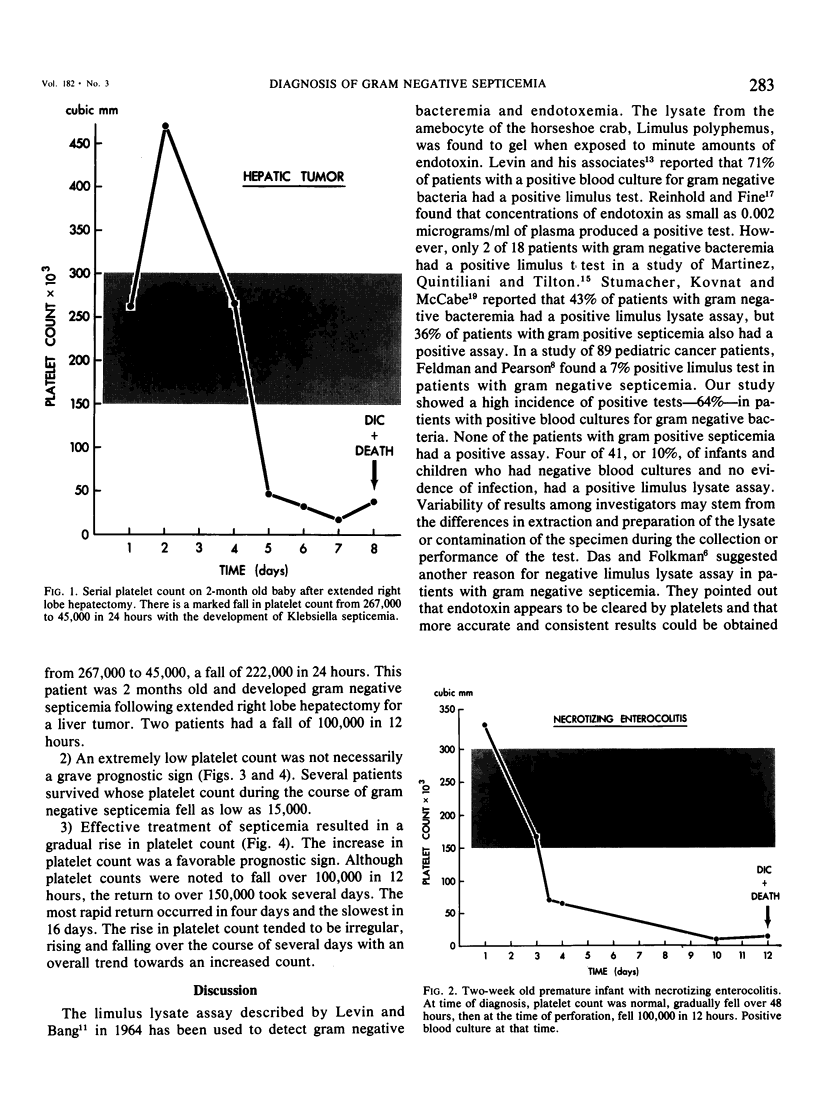Abstract
Ninety-three postoperative patients 1 day to 13 years of age had blood cultures, limulus lysate assay, determination of fibrin degradation products, white blood cell and platelet counts. Seven groups were studied. The limulus lysate assay was often positive (64%) in the presence of gram negative septicemia but there were false positives and negatives. The tests for fibrin degradation products were inconsistent. The white blood cell count was low in babies with gram negative septicemia. One hundred per cent of the infants with gram negative septicemia had a platelet count below 150,000; 71% below 100,000 (average 67,000 septic babies, 257,000 non-septic babies). The drop in platelet count with gram negative septicemia was abrupt---as much as 222,000 in 24 hours. Platelets increased when therapy was effective. Two children with gram negative septicemia had platelet counts of 50,000 and 20,000. The platelet count for patients with gram positive septicemia was 299,000, and above 150,000 in all children with ruptured and non-ruptured appendicitis and major surgery without gram negative septicemia. It was concluded that serial measurements of platelet count in the postoperative infant and child was a rapid and reliable method for early detection of gram negative septicemia and changes in platelet count in response to treatment was an indicator of the effectiveness of therapy.
Full text
PDF






Images in this article
Selected References
These references are in PubMed. This may not be the complete list of references from this article.
- Beller F. K., Douglas G. W. Thrombocytopenia indicating gram-negative infection and endotoxemia. Obstet Gynecol. 1973 Apr;41(4):521–524. [PubMed] [Google Scholar]
- Beller F. K., Graeff H., Gorstein F. Disseminated intravascular coagulation during the continuous infusion of endotoxin in rabbits. Morphologic and physiologic studies. Am J Obstet Gynecol. 1969 Feb 15;103(4):544–554. doi: 10.1016/s0002-9378(15)31857-3. [DOI] [PubMed] [Google Scholar]
- Bull B. S., Schneiderman M. A., Brecher G. Platelet counts with the Coulter counter. Am J Clin Pathol. 1965 Dec;44(6):678–688. doi: 10.1093/ajcp/44.6.678. [DOI] [PubMed] [Google Scholar]
- Chessells J. M. The significance of fibrin degradation products in the blood of normal infants. Biol Neonate. 1971;17(3):219–226. doi: 10.1159/000240315. [DOI] [PubMed] [Google Scholar]
- Corrigan J. J., Jr Thrombocytopenia: a laboratory sign of septicemia in infants and children. J Pediatr. 1974 Aug;85(2):219–221. doi: 10.1016/s0022-3476(74)80396-3. [DOI] [PubMed] [Google Scholar]
- DAVIS R. B., MEEKER W. R., McQUARRIE D. G. Immediate effects of intravenous endotoxin on serotonin concentrations and blood platelets. Circ Res. 1960 Jan;8:234–239. doi: 10.1161/01.res.8.1.234. [DOI] [PubMed] [Google Scholar]
- Feldman S., Pearson T. A. The Limulus test and gram-negative bacillary sepsis. Am J Dis Child. 1974 Aug;128(2):172–174. doi: 10.1001/archpedi.1974.02110270046009. [DOI] [PubMed] [Google Scholar]
- Gurewich V., Hutchinson E. Detection of intravascular coagulation by a serial-dilution protamine sulfate test. Ann Intern Med. 1971 Dec;75(6):895–902. doi: 10.7326/0003-4819-75-6-895. [DOI] [PubMed] [Google Scholar]
- Hawiger J., Niewiarowski S., Gurewich V., Thomas D. P. Measurement of fibrinogen and fibrin degradation products in serum by staphylococcal clumping test. J Lab Clin Med. 1970 Jan;75(1):93–108. [PubMed] [Google Scholar]
- LEVIN J., BANG F. B. A DESCRIPTION OF CELLULAR COAGULATION IN THE LIMULUS. Bull Johns Hopkins Hosp. 1964 Oct;115:337–345. [PubMed] [Google Scholar]
- Levin J., Bang F. B. Clottable protein in Limulus; its localization and kinetics of its coagulation by endotoxin. Thromb Diath Haemorrh. 1968 Mar 31;19(1):186–197. [PubMed] [Google Scholar]
- Lewis A. F., Dickson R. C. Platelet aggregation: induction by means of a complex between endotoxin and copper (Cu 2+ ). Can J Biochem. 1971 Nov;49(11):1236–1244. doi: 10.1139/o71-178. [DOI] [PubMed] [Google Scholar]
- Martinez L. A., Quintiliani R., Tilton R. C. Clinical experience on the detection of endotoxemia with the limulus test. J Infect Dis. 1973 Jan;127(1):102–105. doi: 10.1093/infdis/127.1.102. [DOI] [PubMed] [Google Scholar]
- Nagayama M., Zucker M. B., Beller F. K. Effects of a variety of endotoxins on human and rabbit platelet function. Thromb Diath Haemorrh. 1971 Dec 31;26(3):467–473. [PubMed] [Google Scholar]
- Reinhold R. B., Fine J. A technique for quantitative measurement of endotoxin in human plasma. Proc Soc Exp Biol Med. 1971 May;137(1):334–340. doi: 10.3181/00379727-137-35572. [DOI] [PubMed] [Google Scholar]
- Smith R. T., Ts'ao C. H. Fibrin degradation products in the postoperative period. Evaluation of a new latex agglutination method. Am J Clin Pathol. 1973 Nov;60(5):644–647. doi: 10.1093/ajcp/60.5.644. [DOI] [PubMed] [Google Scholar]
- Stumacher R. J., Kovnat M. J., McCabe W. R. Limitations of the usefulness of the Limulus assay for endotoxin. N Engl J Med. 1973 Jun 14;288(24):1261–1264. doi: 10.1056/NEJM197306142882402. [DOI] [PubMed] [Google Scholar]
- Yip M. L., Lee S., Sacks H. J. Nonspecificity of the protamine test for disseminated intravascular coagulation. Am J Clin Pathol. 1972 Apr;57(4):487–488. doi: 10.1093/ajcp/57.4.487. [DOI] [PubMed] [Google Scholar]






